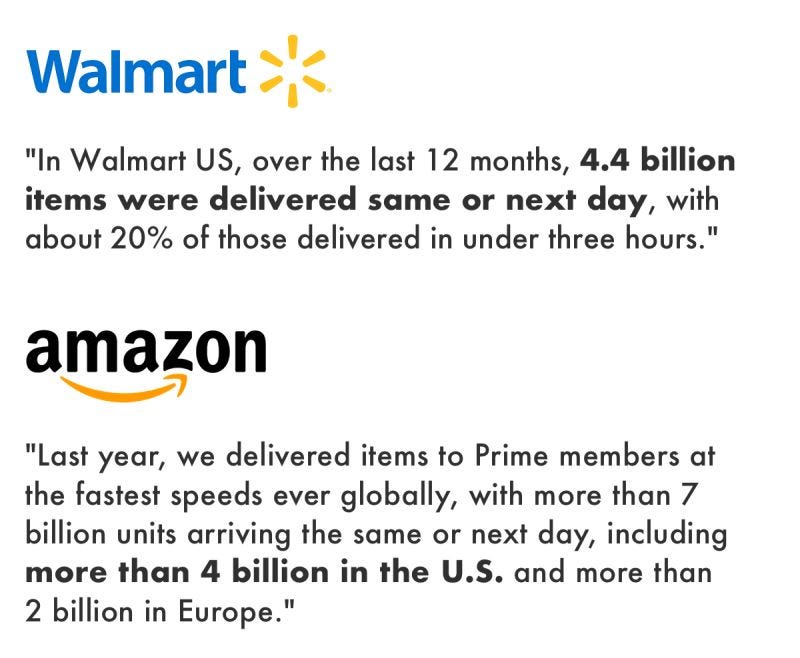Hi everyone,
Let us all say a prayer and take a moment of silence for our troops and their ultimate sacrifice.
In Walmart’s recent earnings release, Doug McMillon, CEO Walmart, bested Amazon.
Walmart ships more packages same-day and next day than Amazon.
Amazon recently reported 4 billion shipments same-day and next day. Establishing the term “same and next day” as a KPI with Wall Street. However, when Walmart reported its quarterly results, they reported 4.4 billion shipments.
Walmart beat Amazon at its own game. How? It’s stores. The large majority of Walmart’s same and next day deliveries are from their network of over 5,000 stores.
B2B Distributors have a lot of stores, too; they’re called branches.
They say that data is the oil of the 21st century. But, I’m pretty sure Home Depot didn’t pay $18 Billion for SRS’s data. Instead, its 750 branches were the oil Home Depot was after.
Amazon v. Walmart and the Battle for Hyperlocal
It was Amazon who has boasted how many billions of dollars it’s investing in its same-day infrastructure. It was Amazon who coined the term “same day and next day” as a reporting metric on its earning call in January. Yet, somehow, Amazon is getting beat on its own KPI … by Walmart!
Amazon has experimented with a lot of local, retail models. They’ve invested in micro-fulfillment centers, their Just Walk Out technology and bought Whole Foods. The only model that’s working is the last one: traditional grocery retail. But, Amazon can’t do more traditional retail if it wishes to hold onto its 50% premium on PE multiple.
Amazon needs to look like a special duckling to justify its $1.9 trillion valuation. When Amazon sets a KPI like same-day, next-day deliveries … and they get beat by the company valued at $520B (Walmart), that doesn’t look good for Amazon and its valuation multiple.
So, if Amazon starts doing traditional retail like Walmart – the allure and mystique of Amazon, the asset-light tech disruptor, gets demystified along with its 50 PE ratio.
Branches are B2B Distribution’s Moat
B2B Distribution has over 150,000 branches – defined as a store that a business customer can walk into and purchase goods from the wholesaler. Compare that to the roughly 15,000 locations big box retailers have.
B2B distributors have more proximity to the customer than big box or tech disruptors. So, let’s lean into that and digitize the experience for the younger generation of buyers.

eCommerce Penetration is Still Below 20%
For all the hype on Amazon and its nearly $2 trillion valuation … all of US retail eCommerce is still less than 20%. As you can imagine, eCommerce in B2B Distribution is much, much lower.
So, if you were Walmart 20 years ago - what would you do differently to stay more competitive with Amazon?
Lean into your existing branch infrastructure as opposed to copying Amazon’s D2C model.
Branches’ Competitive Advantages
Here are a few examples of how distributors can use technology to maximize a branch’s competitive advantage.
Become a premium subscriber to find out!






